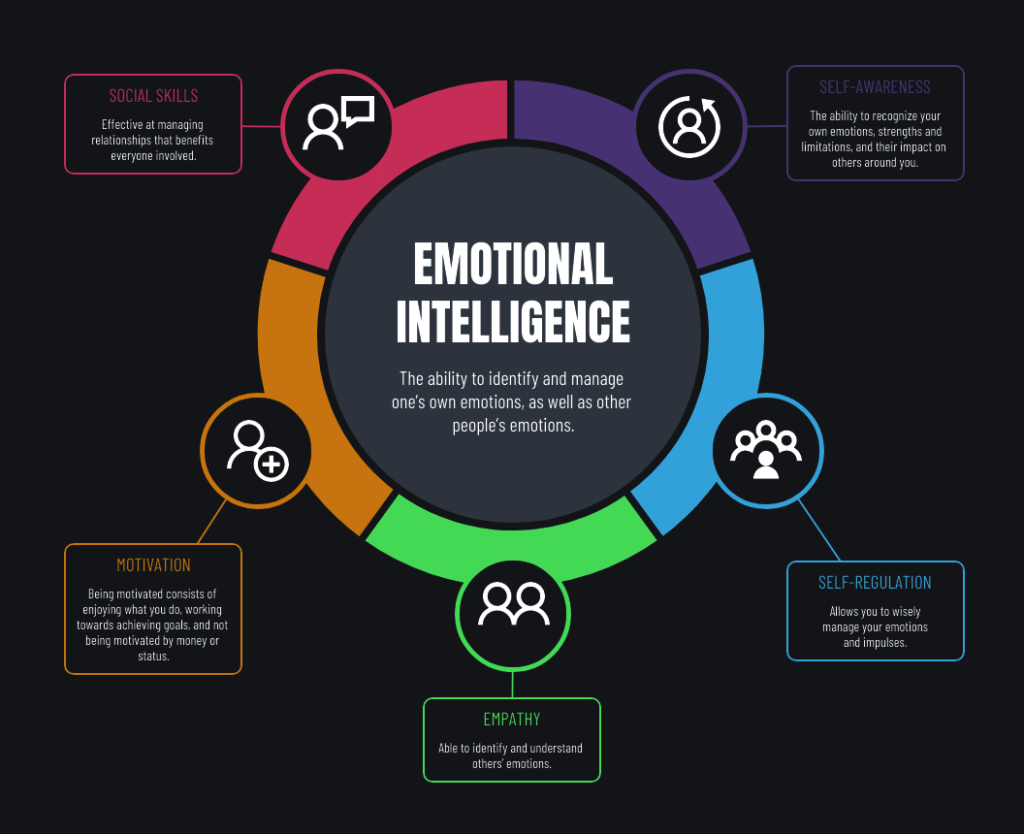5-Minute Guide: Daniel Goleman’s Take on Emotional Intelligence
In the symphony of life, emotional intelligence is the conductor, guiding us through the intricate melodies of human connection, self-awareness, and success.
In the symphony of life, emotional intelligence is the conductor, guiding us through the intricate melodies of human connection, self-awareness, and success.
Join us on an illuminating expedition through the pages of Daniel Goleman’s groundbreaking book, “Emotional Intelligence,” as we unravel the significance of this often overlooked yet crucial aspect of our lives.
Navigate to What Matters
Harmony in Understanding Emotions
Goleman’s exploration begins in the first section, “The Emotional Brain,” where he introduces us to the concept of emotions as the very essence of our humanity. Imagine a scenario: a colleague criticizes your work.
The emotional brain responds instantaneously, triggering feelings of frustration, self-doubt, or even anger.
Goleman takes us through the neural pathways that shape these emotions, explaining how they influence our thoughts and behaviors.
Consider the example of a challenging decision at work. Goleman’s insights shed light on how the limbic system, including the hippocampus, thalamus, and hypothalamus, collaborates to process emotions. This understanding becomes a compass, helping us navigate through the intricate landscape of our reactions.
Fear’s Intricate Dance: The Amygdala Unveiled
Goleman’s discussion on the amygdala in “The Emotional Brain” opens a window into the realm of fear responses. Picture a situation where fear arises – perhaps a public speaking engagement.
The amygdala, that small almond-shaped structure, orchestrates the fear response. Goleman’s narrative provides clarity on why such emotional reactions occur and how they sometimes lead to irrational behavior.
Prefrontal Symphony: The Conductor of Emotional Regulation

As we delve into “The Prefrontal Cortex and Its Role in Emotional Regulation,” consider the prefrontal cortex as the maestro, regulating the emotional symphony. This section provides a lens through which we can view the modulation of emotional responses.
Think of it as the calming influence during a heated discussion, allowing rational decision-making to prevail.
Practical Insights for Everyday Decision-Making
Goleman’s emphasis on the importance of understanding emotions for effective decision-making becomes tangible in scenarios we encounter daily. Imagine a moment of disagreement in a team meeting.
Emotional intelligence, as articulated by Goleman, encourages us to be aware of our emotions and regulate them, transforming potential conflict into constructive dialogue.
Embracing Emotional Intelligence: From Definition to Application
Moving into the heart of the book, “The Nature of Emotional Intelligence,” Goleman defines emotional intelligence as the capacity to recognize and manage our own feelings and those of others.
Let’s bring this definition to life with an example: Imagine a leader who, through self-awareness, acknowledges and regulates their stress during a challenging project. This leader, armed with emotional intelligence, fosters a positive and productive work environment.
Success Symphony: Emotional Intelligence in Personal and Professional Arenas
In “The Importance of Emotional Intelligence in Personal and Professional Success,” Goleman presents research showcasing emotional intelligence as a superior predictor of success compared to IQ.
Consider the contrasting scenarios of two colleagues – one excelling not just due to technical skills but also because of their ability to understand and manage emotions effectively.
A Lifelong Learning Journey
Addressing the common doubt of whether emotional intelligence can be developed, Goleman’s “How Emotional Intelligence Differs from IQ” section becomes a beacon of hope.
Imagine a student who, through self-reflection and emotional intelligence training, transforms their ability to manage stress during exams, leading to improved academic performance.
Real-world Applications: From Relationships to Resilience
“Emotional Intelligence Applied” takes us from theory to practice. Imagine a couple navigating a disagreement. Through empathy, communication, and conflict resolution – components of emotional intelligence – they transform conflict into understanding, fortifying their relationship.
Consider a workplace scenario: A leader with high emotional intelligence inspires and motivates their team effectively. This leader, through social awareness and relationship management, becomes the catalyst for a harmonious and productive work environment.
Windows of Opportunity: A Lifelong Symphony
In “Windows of Opportunity,” Goleman speaks of critical periods in our lives for developing emotional intelligence.
Imagine a child learning to navigate their emotions with guidance from emotionally intelligent parents. This early cultivation becomes a foundation for a resilient and emotionally aware individual.
Common Questions Unveiled
Goleman anticipates and addresses common questions readers may have about emotional intelligence. The importance of emotional intelligence becomes vividly apparent when we consider its role in enhancing relationships, improving well-being, and navigating life’s challenges effectively.
The Heart of “Emotional Intelligence”: A Transformative Guide
In conclusion, “Emotional Intelligence” by Daniel Goleman serves not only as a guide but as a transformative companion in our quest for personal and professional growth. Each page resonates with real-world examples, inviting readers to introspect and apply these insights to their own lives.
As you embark on this transformative journey through “Emotional Intelligence,” consider sharing your thoughts and experiences. Let us together amplify the symphony of emotional intelligence, fostering understanding, empathy, and success in our lives.
-

 Best Picks10 months ago
Best Picks10 months agoDriving Insurance: Get the Best Car Coverage Without Overpaying
-

 Best Rewards3 months ago
Best Rewards3 months agoBest rewards credit cards in 2025 for everyday use
-

 Personal Growth & Mindset1 year ago
Personal Growth & Mindset1 year agoTed Lasso Effect: 5 Goal-Setting Secrets You Must Know
-

 Career & Success1 year ago
Career & Success1 year ago30 Key Strategies for Growth: Mindset, Productivity & Wellness
-

 Personal Growth & Mindset1 year ago
Personal Growth & Mindset1 year agoMachado de Assis: This Viral TikTok Explains Why You Need to Read ‘The Posthumous Memoirs of Brás Cubas’ Now
-

 Career & Success12 months ago
Career & Success12 months agoChallenges of Not Having Goals: 5 tips to help you get started












